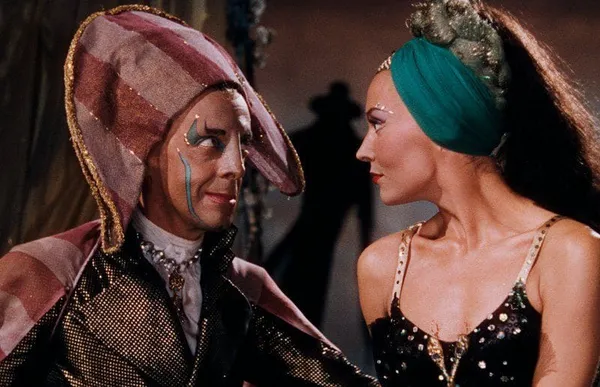Eye For Film >> Movies >> The Tales Of Hoffmann (1951) Film Review

"I suppose there is something meritorious in attempting to merge opera, ballet and movies, but in the present case, the product struck me as being as difficult to countenance as a disorderly menàge á trois." So wrote John McCarten in The New Yorker back in 1951, when Michael Powell and Emeric Pressburger's The Tales Of Hoffmann first screened in cinemas.
The passage of time - and a beautiful 4k restoration - have been kind to this reimagining of Jacques Offenbach's opera, with its deliberately operatic gestures and colours and stylised production design feeling sharply avant garde even today. Bolstered, no doubt, from their experiences of bringing ballet off the stage and into a cinematic arena in The Red Shoes, the filmmakers use the freedom of camerawork to emphasise ideas and themes from the opera even though they deliberately retain a 'staged' quality to the work.

The story concerns the titutlar Hoffmann (Robert Rounseville, on singing and acting duty) and a succession of doomed romances and is framed by a story in which his nemesis (Robert Helpmann - with Robert Dagavel on vocals - who takes on bad guy duties in all three of the film's 'acts') attempts to thwart Hoffmann's love for a prima ballerina (Moira Shearer). Waiting for her to finish her performance - a good excuse for Powell and Pressburger to let Shearer pirouette her stuff in a dragonfly ballet that is an addition to Offenbach's original - Hoffmann heads to a local tavern where he regales the drinkers with three stories from his life.
Each tale is connected by romance and tragedy and was intended by Offenbach to represent three aspects of his beloved ballerina's personality, although here - as in many operatic versions of the work - they are played by different actresses. In the first, the young Hoffmann falls for mechanical doll Ophelia (Shearer, Dorothy Bond on aria duties) - rendered human by a pair of magical spectacles he is wearing - but she is, of course, doomed to discovery. In the second, Hoffmann is transported to Venice where his desires for courtesan Guilietta (Ludmilla Tchérina, Margherita Grandi at the mic) threaten to steal his soul while in the third he finds himself on a Greek Island where his love for consumptive singer Antonia (Ann Ayars, on double duty) is scotched by her inability to give up music.
The production design by Hein Heckroth is flamboyantly fabulous throughout, from the yellow-dominated doll scenes, which see puppets come inventively to life, to the sumptuous and dangerous reds and greens of Venice and the cool ocean blues of the Greek segment. The costumes and make-up create an aria of their own, particularly in scenes where the puppets dance, wearing flower petals around their eyes in a profusion of colour - and if there were ever a special Oscar for eyebrows, this would surely take it home. It goes without saying that you have to have at least a passing interest in opera to enjoy this - it is sung-through, so there is no escape from Offenbach's music - but Powell and Pressburger's visual flair enhances the score without overwhelming it. Thomas Beecham conducts the Royal Philharmonic Orchestra and the singers, with Rounseville particularly fine in the tenor role of Hoffmann. Frederick Ashton's choreography pirouettes and pliés throughout the piece, with balletic moves emphasised even in the' non-dance' moments.
Ideas of voyeurism (something Powell would go on to explore further in Peeping Tom) are sown from the outset, as we gradually close in on a conversation at first seen through a window, and characters are frequently seen listening in on conversations or peeping out from hiding places; curtains open to more curtains in the Olympia segment as we see the layers laid out. The puppeteer theme, although most overt in the Ophelia segment, also crops up throughout, as characters - in particular those played by Helpmann - attempt to manipulate those around them and the sense of artifice and fate are never far away. This is primarily, however, a visual and aural spectacle, contrasting the sparseness of the sets - often black or expressionistic in their visuals - with the outlandishness of the costuming and music to memorable effect.
The third segment suffers from being less visually arresting than the previous two - and from a less fantastical plotline - although Antonia's demise is a special effects showcase. Far from being a disorderly menàge á trois, The Tales Of Hoffmann now feels more like an orchestrated orgy of ideas that only starts to stumble when its exhuberance is muted.
Reviewed on: 26 Mar 2015
















